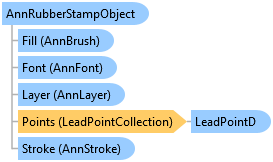| Leadtools.Annotations.Core Namespace : AnnRubberStampObject Class |

public class AnnRubberStampObject : AnnRectangleObject, IAnnObjectCloneable
Public Class AnnRubberStampObject Inherits AnnRectangleObject Implements IAnnObjectCloneable
public sealed class AnnRubberStampObject : IAnnObjectCloneable
@interface LTAnnRubberStampObject : LTAnnRectangleObject<NSCoding,NSCopying>
public class AnnRubberStampObject extends AnnRectangleObject
function Leadtools.Annotations.Core.AnnRubberStampObject()
The rubber stamp annotation object is an image that has a predefined metafile.
Programmatically, the boundaries and location of the rubber stamp object can be controlled using the following properties:
The AnnRubberStampObject class inherits a number of properties from the AnnObject class, providing support for font, stroke and fill characteristics. These properties are listed below:
The name of the rubber stamp object can be controlled using Labels property, inherited from the AnnObject class.
Each object can be transformed with the following methods:
The following properties can also be used to programmatically set characteristics of an AnnRubberStampObject:
 Copy Code
Copy Code
using Leadtools.Annotations.Automation; using Leadtools.Annotations.Core; using Leadtools.Codecs; using Leadtools.WinForms; public void AnnCore_AnnRubberStampObject() { // assumes _automation is valid // Create a new instance of AnnResources if the container does not already have one AnnResources resources = _automation.Container.Resources; if (resources == null) { resources = new AnnResources(); _automation.Container.Resources = resources; } // Get the rubber stamp collection Dictionary<AnnRubberStampType, AnnPicture> rubberStampsResources = resources.RubberStamps; // Add our picture to it rubberStampsResources[AnnRubberStampType.StampFaxed] = new AnnPicture(@"ms-appx:///Assets/Faxed.png"); double inch = 720.0; // Add a rubber stamp object AnnRubberStampObject rubberStampObj = new AnnRubberStampObject(); // Set the points for the hotspot rubberStampObj.Points.Add(LeadPointD.Create(1 * inch, 1 * inch)); rubberStampObj.Points.Add(LeadPointD.Create(2 * inch, 1 * inch)); rubberStampObj.Points.Add(LeadPointD.Create(2 * inch, 2 * inch)); rubberStampObj.Points.Add(LeadPointD.Create(1 * inch, 2 * inch)); // Set the rubber stamp type rubberStampObj.RubberStampType = AnnRubberStampType.StampFaxed; // Add the object to the automation container _automation.Container.Children.Add(rubberStampObj); // Select the object _automation.SelectObject(rubberStampObj); }
using Leadtools.Converters; using Leadtools.Annotations.Automation; using Leadtools.Controls; using Leadtools.Annotations.Core; using Leadtools.Codecs; [TestMethod] public void AnnCore_AnnRubberStampObject() { // assumes _automation is valid // Create a new instance of AnnResources if the container does not already have one AnnResources resources = _automation.Container.Resources; if (resources == null) { resources = new AnnResources(); _automation.Container.Resources = resources; } // Get the rubber stamp collection Dictionary<AnnRubberStampType, AnnPicture> rubberStampsResources = resources.RubberStamps; // Add our picture to it rubberStampsResources[AnnRubberStampType.StampFaxed] = new AnnPicture(@"ms-appx:///Assets/Faxed.png"); double inch = 720.0; // Add a rubber stamp object AnnRubberStampObject rubberStampObj = new AnnRubberStampObject(); // Set the points for the hotspot rubberStampObj.Points.Add(LeadPointDHelper.Create(1 * inch, 1 * inch)); rubberStampObj.Points.Add(LeadPointDHelper.Create(2 * inch, 1 * inch)); rubberStampObj.Points.Add(LeadPointDHelper.Create(2 * inch, 2 * inch)); rubberStampObj.Points.Add(LeadPointDHelper.Create(1 * inch, 2 * inch)); // Set the rubber stamp type rubberStampObj.RubberStampType = AnnRubberStampType.StampFaxed; // Add the object to the automation container _automation.Container.Children.Add(rubberStampObj); // Select the object _automation.SelectObject(rubberStampObj); }